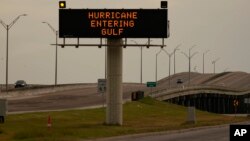Beryl began lashing Texas with rain and intensifying winds Sunday as coastal residents boarded up windows, left beach towns under evacuation orders and prepared for the powerful storm that has already cut a deadly path through parts of Mexico and the Caribbean.
Although Beryl remained a tropical storm Sunday as it churned toward Texas, it threatened to potentially regain hurricane strength in the warm waters of the Gulf of Mexico before making landfall early Monday. The storm was projected to come ashore in the middle of the Texas coast around Matagorda Bay, an area about 161 kilometers (100 miles) south of Houston, but officials cautioned the path could still change.
Texas officials warned the storm would cause power outages and flooding but also expressed worry that not enough coastal residents and beach vacationers in Beryl's path were heeding warnings to leave.
"One of the things that kind of trigger our concern a little bit, we've looked at all of the roads leaving the coast and the maps are still green," said Texas Lt. Gov. Dan Patrick, who is serving as the state's acting governor while Gov. Greg Abbott is traveling overseas. "So we don't see many people leaving."
Along the Texas coast, many residents and business owners took the typical storm precautions, but also expressed uncertainty about the storm's intensity.
In Port Lavaca, Jimmy May fastened plywood over the windows of his electrical supply company and said he wasn't concerned about the possible storm surge. He recalled that his business had escaped flooding in a previous hurricane that brought a 6-meter storm surge.
"In town, you know, if you're in the low-lying areas, obviously, you need to get out of there," he said.
At the nearby marina, Percy Roberts showed his neighbor Ken Waller how to properly secure his boat as heavy winds rolled in from the bay Sunday evening.
"This is actually going to be the first hurricane I'm going to be experiencing," Waller said, noting that he's a little nervous but feels safe following Roberts' lead. "Pray for the best but expect the worst, I guess."
Farther down the coast in Freeport, Mark Richardson, a 64-year-old retiree, said homeowners were busy "trying to tie everything down" and worried that Beryl had people unsure about where along the Texas coast it would make landfall. He spent Sunday morning on the beach and said ocean swells were quickly rising.
"The ocean is getting very angry, very fast," he said.
The earliest storm to develop into a Category 5 hurricane in the Atlantic, Beryl caused at least 11 deaths as it passed through the Caribbean on its way to Texas. The storm ripped off doors, windows and roofs with devastating winds and storm surge fueled by the Atlantic's record warmth.
Three times in its one week of life, Beryl has gained 56 kph in wind speed in 24 hours or less, the official weather service definition of rapid intensification.
Beryl's explosive growth into an unprecedented early whopper of a storm shows the literal hot water of the Atlantic and Caribbean, and what the Atlantic hurricane belt can expect for the rest of the storm season, experts said.
Texas officials warned people along the entire coastline to prepare for possible flooding, heavy rain and wind. The hurricane warning extended from Baffin Bay, south of Corpus Christi, to Sargent, south of Houston.
Beryl lurked as another potential heavy rain event for Houston, where storms in recent months have knocked out power across the nation's fourth-largest city and flooded neighborhoods. A flash flood watch was in effect for a wide swath of the Texas coast, where forecasters expected Beryl to dump as much as 25 centimeters of rain in some areas.
Potential storm surges between 1.22 and 2.13 meters above ground level were forecast around Matagorda. The warnings extended to the same coastal areas where Hurricane Harvey came ashore in 2017 as a Category 4 hurricane, far more powerful than Beryl's expected intensity by the time the storm reaches landfall.
Those looking to catch a flight out of the area could find that option all but impossible as Beryl closed in. Hundreds of flights from Houston's two major commercial airports had been delayed by midafternoon Sunday and dozens more canceled, according to FlightAware data.
In Corpus Christi, officials asked visitors to cut their trips short and return home early if possible. Residents were advised to secure homes by boarding up windows if necessary and using sandbags to guard against possible flooding.
The White House said Sunday that the Federal Emergency Management Agency had sent emergency responders, search-and-rescue teams, bottled water, and other resources along the coast.
Several coastal counties called for voluntary evacuations in low-lying areas that are prone to flooding. Local officials also banned beach camping and urged tourists traveling on the Fourth of July holiday weekend to move recreational vehicles from coastal parks.
Beryl earlier this week battered Mexico as a Category 2 hurricane, toppling trees but causing no injuries or deaths before weakening to a tropical storm as it moved across the Yucatan Peninsula.
Before hitting Mexico, Beryl wrought destruction in Jamaica, St. Vincent and the Grenadines, and Barbados. Three people were reported dead in Grenada, three in St. Vincent and the Grenadines, three in Venezuela and two in Jamaica.
Beryl would be the 10th hurricane to hit Texas in July since 1851 and the fourth in the last 25 years, according to Colorado State University hurricane researcher Phil Klotzbach.










